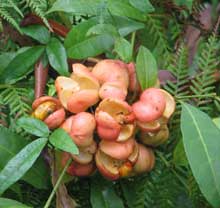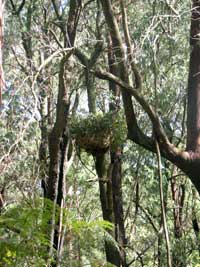
The Giant Snow Gums Walk in Coolah Tops National Park took me into a world totally new to me.
Here Eucalyptus pauciflora grow tall and straight, not low and blizzard-racked like the sort of snow gum I had in mind, as in the Snowy Mountains.
This open forest has a lower storey of a strange wattle, slender dark trunks bearing no lower branches beneath their oriental umbrellas of bluish-green.
To me their fluid shapes have a rather sinister frozen-in-action look. And are they whispering to each other up there as they lean towards each other?
Or are they receiving instructions to let me pass or not? Perhaps from the gargoyle mouth on the mighty snow gum just ahead?



 My forest does not have much understorey but in the damper dips and gullies there are always pockets of a small tree—scentless rosewood, Synoum glandulosum.
My forest does not have much understorey but in the damper dips and gullies there are always pockets of a small tree—scentless rosewood, Synoum glandulosum. As you might expect, given that I live in forest country, I love trees.
As you might expect, given that I live in forest country, I love trees.
 Even when a tree is totally destroyed, its trunk broken off and laid low, taken from skydweller to ground hugger, it takes on new life as host. Like this mighty ancient, which blocked the track for some time until a big enough chainsaw came along.
Even when a tree is totally destroyed, its trunk broken off and laid low, taken from skydweller to ground hugger, it takes on new life as host. Like this mighty ancient, which blocked the track for some time until a big enough chainsaw came along.